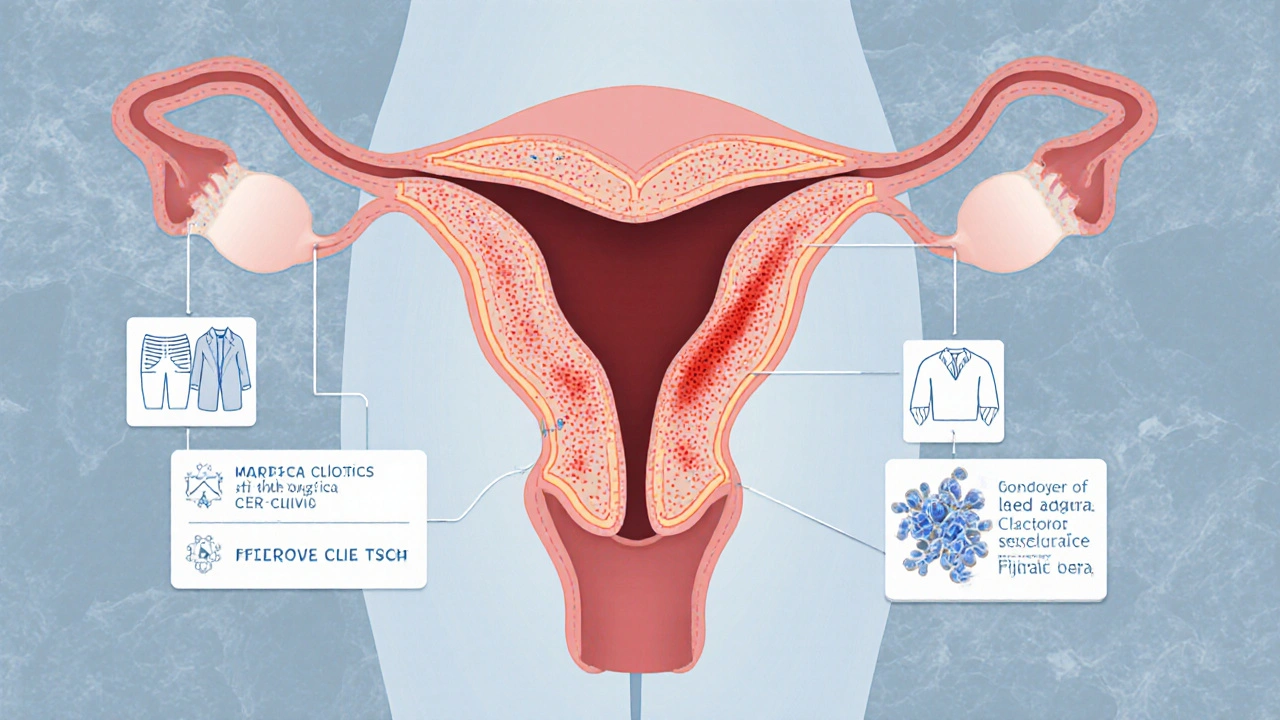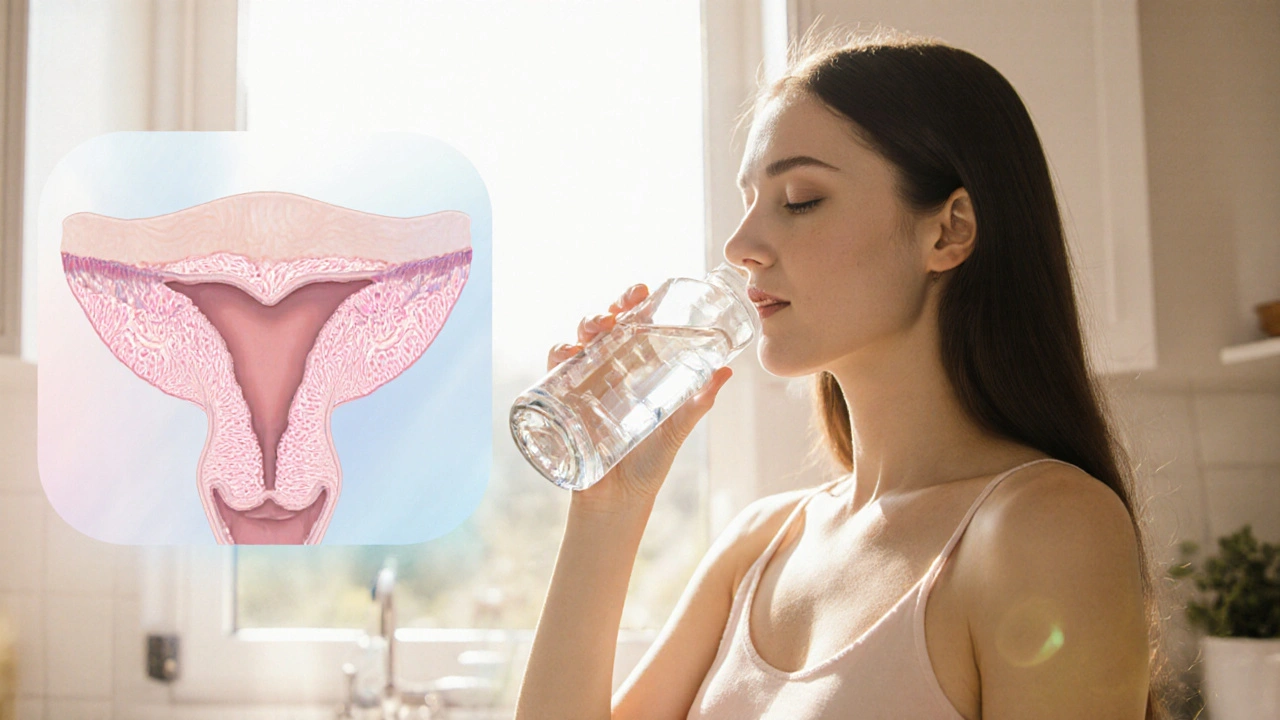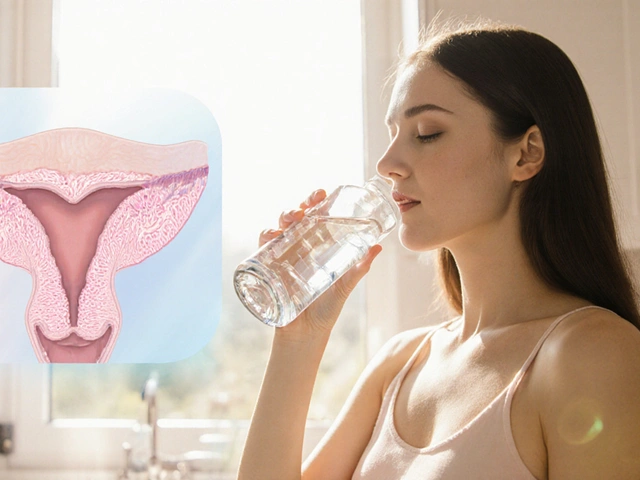Vaginal Hydration Checker
Your Hydration Assessment
When it comes to intimate comfort, many women overlook a simple habit that can make a huge difference: drinking enough water. Vaginal irritation is a condition where the delicate lining of the vagina becomes red, itchy, or painful, often triggered by factors like low moisture, pH shifts, or friction. One of the most overlooked triggers is dehydration, which dries out the mucosal tissue and throws off the natural balance.
Key Takeaways
- Proper hydration keeps vaginal tissue lubricated and maintains a healthy pH.
- Dehydration can lead to itching, burning, and increased susceptibility to infections.
- Aim for at least 2liters of water daily, adjusted for activity, climate, and personal health.
- Combine water intake with foods rich in electrolytes and low‑sugar drinks for optimal tissue health.
- Seek medical advice if irritation persists despite good hydration habits.
How Hydration Impacts Vaginal Tissue
The vagina is lined with a mucous membrane that stays supple thanks to a mix of water, natural secretions, and electrolytes. Hydration refers to the balance of fluids inside the body, essential for every cell and organ supplies the water needed for these secretions. When you’re well‑hydrated, the vagina can maintain its moisture barrier, which helps keep the pH in the optimal range of 3.8‑4.5.
If fluid levels dip, the mucosal layer thins, making it easier for friction from clothing or sexual activity to cause micro‑tears. Those tiny openings become entry points for bacteria, leading to itching, burning, or even a secondary infection like a yeast overgrowth.
Signs That Dehydration May Be Irritating Your Vagina
- Persistent itching or a sand‑paper feeling inside the labia.
- Increased dryness during intimate moments, requiring extra lubricant.
- A mild burning sensation after urination, not accompanied by classic UTI symptoms.
- Noticeable change in discharge - it may become thinner, less abundant, or develop an off‑color.
- General fatigue, dry mouth, or dark‑yellow urine, indicating overall low fluid intake.
These signs often overlap with other conditions, but they’re a good hint that your water intake deserves a look.
Practical Steps to Stay Well‑Hydrated
Here’s a no‑nonsense plan you can start today:
- Carry a refillable 500ml bottle and sip every 20‑30minutes.
- Set phone reminders if you tend to forget during busy workdays.
- Swap sugary sodas for infused water-add cucumber, lemon, or mint for flavor without the sugar spike.
- Eat water‑rich foods such as watermelon, cucumber, strawberries, and oranges.
- Include a pinch of sea salt or a splash of electrolyte drink after heavy exercise or on very hot days.
When you’re staying hydrated consistently, you’ll notice the itching ease and the need for extra lubricants drop dramatically.

Foods and Drinks That Boost Vaginal Health
Beyond plain water, certain nutrients support the vaginal ecosystem directly:
| Food / Drink | Key Hydrating Component | Additional Vaginal Health Benefit |
|---|---|---|
| Watermelon | 92% water | Contains lycopene, which may reduce inflammation. |
| Coconut water | Electrolyte‑rich fluid | Supports natural mucus production. |
| Greek yogurt | Moisture‑binding protein | Probiotic cultures help maintain a healthy vaginal microbiome. |
| Leafy greens (spinach, kale) | High water content | Rich in magnesium, which assists muscle relaxation and reduces cramping. |
| Herbal teas (ginger, chamomile) | Warm fluid intake | Ginger has anti‑inflammatory properties; chamomile soothes irritation. |
These choices keep you hydrated while also feeding the beneficial bacteria that protect against irritation.
Common Myths About Vaginal Moisture
Myth 1: "Only sexual arousal determines vaginal wetness." In reality, basal moisture is continuously produced by the mucosal lining, and adequate hydration is a core driver.
Myth 2: "All scented products are safe because they smell nice." Fragranced soaps, wipes, or pads can strip natural oils, worsening dryness. Opt for unscented, pH‑balanced options.
Myth 3: "You can’t drink too much water." Over‑hydration can dilute electrolytes, leading to hyponatremia, which also causes tissue swelling and discomfort. Balance is key.
When to See a Healthcare Professional
If you’ve boosted your water intake for a week and still experience intense itching, burning, or abnormal discharge, it’s time to get checked. Persistent irritation can mask infections such as bacterial vaginosis, yeast infections, or even early‑stage urinary tract infections.
During a visit, doctors often assess:
- Overall fluid intake and urine color.
- pH level of vaginal secretions.
- Potential allergic reactions to hygiene products.
- Hormonal factors like low estrogen, which can also thin vaginal tissue.
Treatment may involve topical moisturizers, prescription lubricants, or addressing underlying hormonal changes.
Quick Checklist for Vaginal Comfort
- Drink at least 2liters of water daily; more if active or in hot climates.
- Include water‑rich fruits and vegetables in every meal.
- Avoid scented soaps, douches, and harsh laundry detergents.
- Wear breathable cotton underwear; change after workouts.
- Use a water‑based lubricant if sexual activity feels dry.
- Schedule a check‑up if irritation lasts longer than a week despite good hydration.
Frequently Asked Questions
How much water should a woman drink to prevent vaginal dryness?
Most experts recommend 2liters (about 8 cups) of plain water per day, but the exact amount depends on activity level, climate, and individual metabolism.
Can drinking extra water replace the need for lubricants during sex?
Hydration improves overall tissue moisture, but during sexual activity you may still benefit from a water‑based lubricant, especially if you’re exercising or in a dry environment.
What drinks should I avoid if I’m worried about vaginal irritation?
Limit sugary sodas, excessive caffeine, and alcohol. These can dehydrate you and alter the vaginal pH, making irritation more likely.
Is there a link between estrogen levels and vaginal dryness?
Yes. Low estrogen, common during menopause or certain hormonal conditions, thins the mucosal lining, reducing natural lubrication. Hydration helps but may not fully counteract hormonal effects.
Can probiotic foods help prevent irritation?
Probiotic‑rich foods like Greek yogurt and kefir support a healthy Lactobacillus‑dominant vaginal microbiome, which can reduce the risk of irritation and infection.



They dont tell you how big the water industry is secretly controlling our vaginas
Staying hydrated isn’t just about chugging water; it’s about timing and food choices.
Carry a reusable bottle and sip steadily throughout the day so your body never hits a dehydration dip.
Include water‑rich fruits like watermelon and cucumber in snacks for extra moisture.
When you’re active or in a hot climate, bump that intake up by at least a half‑liter.
And remember, a pale‑yellow urine color is a simple visual cue that you’re on the right track.
I’ve noticed that when I keep a bottle handy i’m less likely to feel that sandpaper feeling down there.
Setting a timer on my phone helps me remember to take a sip every 30 minutes.
Also, munching on cucumbers or strawberries adds hydration without any extra effort.
Just a small habit change, and the itching improves dramatically.
Water, the fluid that mirrors our thoughts, is the silent architect of our internal ecosystems.
When the body is deprived of this essential element, the mucosal linings lose their supple resilience.
Consequently, micro‑tears appear, inviting unwelcome microorganisms.
This cascade explains why dehydration can masquerade as irritation or infection.
Restoring balance through consistent intake re‑establishes the barrier function.
Thus, the simple act of drinking becomes a philosophical commitment to bodily harmony.
Sure, because the universe definitely cares about your water intake more than your morning coffee.
A good rule of thumb is to drink enough so your urine is pale yellow; if it’s darker, add another glass.
Actually, the article says “2 liters” not “2liters”; precision matters when discussing health.
Wake up! The hidden agenda of the soda cartel is draining our very essence!
From a pathophysiological standpoint, extracellular fluid volume directly influences mucosal transudate production, which in turn sustains vaginal lubrication.
Insufficient intake reduces plasma osmolality, leading to a thinner epithelial barrier and heightened susceptibility to irritants.
Therefore, maintaining optimal hydration is not merely comfort‑centric; it’s a cornerstone of barrier integrity.
Indeed, the synergy between hydration and microbiome balance is like a well‑tuned orchestra 🎶
Keep a reminder on your phone; consistency beats intensity.
When you make a habit of drinking enough water each day, you’re essentially giving your body the raw material it needs to keep every cell humming smoothly.
That includes the delicate epithelial cells lining the vagina, which rely on a steady supply of fluid to stay plump and lubricated.
Without sufficient hydration, those cells can become thin and fragile, turning everyday motions into sources of irritation.
Imagine trying to write on dry paper versus moist paper; the latter glides effortlessly, the former tears and crumples.
Similarly, a well‑hydrated mucosa slides past itself without friction, while a dehydrated one feels rough and uncomfortable.
Studies show that a pale‑yellow urine color correlates with optimal systemic hydration, so it’s a quick visual check you can trust.
On the flip side, dark amber urine signals a deficit that likely extends to your vaginal tissues.
Increasing fluid intake isn’t just about water; electrolytes from coconut water or a pinch of sea salt help retain that moisture where it matters most.
Including water‑rich foods like watermelon, cucumber, and strawberries adds a bonus hydration boost without even thinking about it.
Probiotic‑laden foods such as Greek yogurt further support the vaginal microbiome, creating a thriving environment that resists irritation.
Even on busy days, a simple habit like placing a 500 ml bottle on your desk can remind you to sip regularly.
Set an alarm if you tend to forget, and you’ll notice the difference within a week.
If after a solid week of consistent intake you still feel the sand‑paper sensation, it may be time to consult a professional, because other factors like hormones or infection could be at play.
Overall, the link between hydration and vaginal comfort is clear: water fuels the body’s natural lubrication system, keeping everything running smooth and pain‑free.
Your passion is contagious; keep spreading the word!
You’ve got this! Small daily steps lead to big comfort gains 😊
I agree and would add that tracking intake with an app can make a real difference.